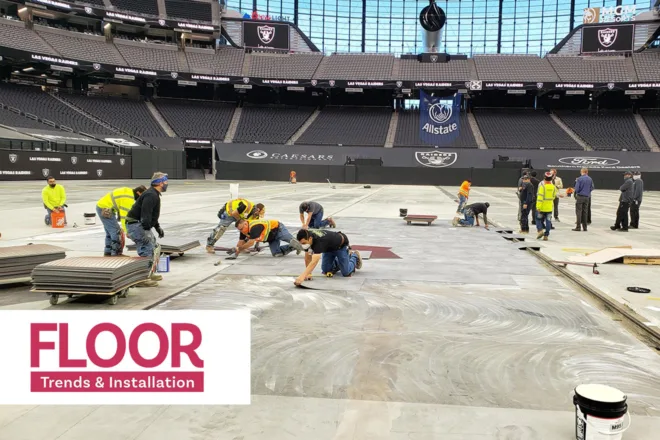
*This article by INSTALL executive director David Gross was originally featured in Floor Trends & Installation.
Why Sports Flooring Is a Winning Play for Installers
From elementary gym floors to professional football fields, rising demand for high-quality, high-performance sports surfaces is creating more opportunities for flooring installers with the right experience. Getting into the game increasingly requires certification and specialized training in sports flooring. What installers may be surprised to learn is that much of this training builds on the skills they already have.
TRADITIONAL SKILLS, SPECIALIZED SURFACES
Making the move from traditional flooring into a specialized sports surface is not as great a leap as many might think, as most sports installations employ the same fundamental skills as their counterparts (think carpet and synthetic turf). What distinguishes sports surfaces is greater precision to create a finished floor that meets a higher set of standards. For example:
Substrate prep. Sports subfloors must be leveled to tighter tolerances, and some include specialized underlayments to control performance attributes such as shock absorption. Proper substrate prep is essential for athlete safety. It is also vital in professional venues where surfaces must deliver a comparable play experience from court to court or field to field.
Materials and installation techniques. Sports flooring includes a range of specialized materials and systems, each with its own manufacturer-defined installation steps that must be followed to the letter to guarantee performance and warranty protection.
Standards. Sports surfaces must meet specific athletic standards established by governing bodies such as ASTM International, the NCAA, and professional organizations like the NFL and the NBA. These standards define the flooring’s safety and gameplay performance using metrics for shock absorption, ball bounce, traction, and energy return.
Documentation. Sports flooring installations are frequently accompanied by additional rules and documentation requirements, particularly for government-funded projects. Contractors familiar with the extra paperwork and expectations often have an edge.
While sports flooring is clearly distinguished from the everyday residential or commercial project, stepping into this specialized sector is less about starting over and more about expanding and mastering skills for more sophisticated types of installations.
CAREER HIGHLIGHTS
Updated material formulations, faster cure times, and eco-friendly options are making sports surfaces like synthetic turf, pad-and-pour polyurethane, and resin/rubber systems more appealing. They are also creating fresh demand for certified installers with the right training. To see where traditional installation skills cross into modern sports expertise, here’s a closer look at some high-tech, high-demand surfaces.
Synthetic turf has evolved with improved fiber technology and advanced multi-layer backing systems that create natural-looking surfaces without the need for infill. Turf installation shares traditional carpet’s gluing, stretching, and seam-sewing skills but demands tighter tolerances to ensure player safety and meet game-play standards. Practiced carpet installers are well-positioned for synthetic turf with additional training in areas like substrate prep, layout and seam alignment, and cutting and detailing.
Pad-and-pour polyurethane is a seamless flooring system that uses a rubber pad and poured-over polyurethane layers to create a durable, cushioned playing surface. Resilient flooring installers can easily transition into pad-and-pour systems since many of the preparation and finishing skills overlap. Specialized training in liquid handling, specifically mixing, timing, and pouring the polyurethane layers, is highly recommended for installers who want to bid and perform this type of work.
Rubber/resin flooring offers a different take on resilient sports surfaces. Instead of pouring layers over a pad, these systems blend recycled rubber granules with polyurethane resin to create a dense, impact-absorbing base that’s typically topped with a smooth, colored wear coat. For installers, rubber/resin flooring builds on familiar resilient techniques but focuses more on trowel application and careful control of curing conditions.
Maple hardwood remains the gold standard for professional indoor sports, particularly basketball and volleyball. These floors use high-grade MFMA-certified maple over highly engineered subfloor systems to deliver uniform shock absorption and ball response. Carpentry and installation techniques mirror those used in residential or commercial wood flooring, but with greater precision in wood grading, subfloor construction, game line painting, and performance testing compliance.
Final Pro Tip: To compete for sports flooring projects like these, installers are increasingly required to be certified and to have completed training specific to the system being installed. Organizations like the International Standards & Training Alliance (INSTALL), which partner with leading sports flooring manufacturers, offer the most up-to-date hands-on instruction. Installers interested in advancing into sports flooring are encouraged to explore certification programs and manufacturer-sponsored training opportunities to move off the bench and onto the playing field.
